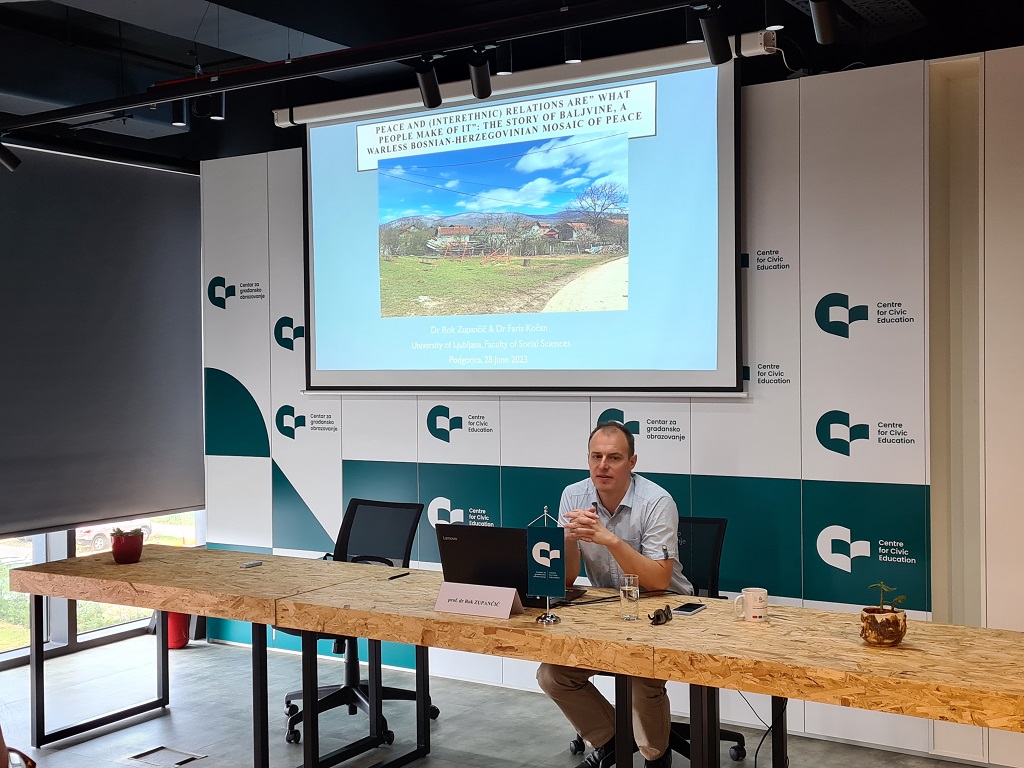In Baljvine, Bosniaks and Serbs protected each other during the 1992-1995 war, and unlike the rest of Bosnia and Herzegovina, there was no inter-ethnic bloodshed, which is why it was called the “village of peace” in several media reports. That is why, it was also the inspiration for the research that was presented today, in the organisation of the Centre for Civic Education (CCE) and the Faculty of Social Sciences of the University of Ljubljana.
“Many of us have not heard of Baljvine, but have heard of the war events in places like Srebrenica and Vukovar. Although a lot of media and interest is focused on these examples, there is little research on places like the village of Baljvine, which is why we decided on this analysis,” said Dr. Rok Zupančič, associate professor at the University of Ljubljana, who presented the research findings.
As Zupančić explains, there are two segments of this research – the elucidation of the factors that led to bypassing the high ethnic distance in some places, while in others it did not succeed, and the attempt to develop a model for reducing the ethnic distance. “This analysis approach was applied to Baljvine, but also to two other cases included in the study – Kamenica in Kosovo and some villages in Gorski kotar in Croatia. Baljvine, which we are talking about today, is the only village in Republika Srpska where the mosque was not destroyed during the 1992-1995 war, where the Bosniaks were protected by the Serbs and good inter-ethnic relations have been maintained to this day, and this is not the interpretation of the Serbs, but Bosniaks too“, stated Zupančič.
The research focused on factors that contributed to peace in the village before, during and after the 1992-1995 war. Speaking about the reasons why inter-ethnic relations in post-conflict ‘divided cities’ remain hostile with pronounced ethnic distance despite intensive efforts to build peace, while in other cities in post-conflict society relations between the same ethnic groups can be peaceful, and ethnic distance is low, Zupančič points out a set of factors but also a dose of luck that complements the mosaic. “First of all, there is a historical narrative that when the Ustaše came to the village during World War II, the Bosniaks rose up against them and protected the Serbs from violence. In the 1990s, this protective narrative was retained, which indicates its great importance and influence on interpersonal relations,” he explains. Among other key factors, he cites the economic, in the context of poverty and lack of water supply to the village, then the geographical (geopolitical), that is, the distance from the main military route that would threaten this village more, and what was the fate of the surrounding villages. Also, he classifies total political mistrust, common “enemy” and wise informal and religious local leaders who played important and constructive roles in keeping the peace, trying to calm down and not incite tensions in the village. “However, it is interesting that although the multiethnic distance is very low, the concept of mixed marriage is not acceptable among the locals,” he states.
The presentation brought together young researchers from the academic community and activists from the civil society.
The research in this village is part of the research project “Anxious Peace” (Anxieties in the cities of post-conflict societies of Southeast Europe: introducing an integrative approach to peace building), which is financed by the Slovenian Research Agency. The project aims to answer the question – how to reduce the ethnic distance between people who were previously involved in armed conflicts and, overall, to improve inter-ethnic relations in post-conflict societies.
Maja Marinović, Programme Associate


